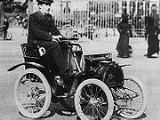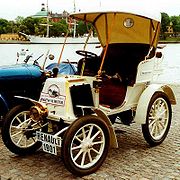
Renault Voiturette
Encyclopedia
The Renault Voiturette was Renault
's first ever produced automobile, and was manufactured between 1898 and 1903. The name was used for five models.
The first Voiturettes mounted De Dion-Bouton
engines, which were used until the mid seventies for several Renault automobiles. Continental
tires were used for the car, and curiosly, several modern Renaults still use Continental.
in 1898. The first Voiturette was sold to a friend of Louis' father after going for a ride with Louis through Lepic street on December 24, 1898. Twelve more cars were sold that night. The main reason for the man to buy the car was the incredible ability of the car to climb streets without any difficulty and its fuel economy.
The car mounted a De Dion-Bouton 1 cylinder engine, which allowed it to reach a top speed of 32 km/h (20 mph).
The car was presented in the 1900 Mondial de l'Automobile
at Paris
, presenting for the first time Renault Frères as an automobile maker.
 The Type D and E Voiturettes were similar to the Type C but with some differences, mostly the 5CV upgraded engine. The Type D was identical to the Type C excepting the retractable roof and the Type E showed a longer roof than that of the Type B, but without any door.
The Type D and E Voiturettes were similar to the Type C but with some differences, mostly the 5CV upgraded engine. The Type D was identical to the Type C excepting the retractable roof and the Type E showed a longer roof than that of the Type B, but without any door.
The Type G used the same chassis and body style than the Type D and E but with an upgraded engine.
Renault
Renault S.A. is a French automaker producing cars, vans, and in the past, autorail vehicles, trucks, tractors, vans and also buses/coaches. Its alliance with Nissan makes it the world's third largest automaker...
's first ever produced automobile, and was manufactured between 1898 and 1903. The name was used for five models.
The first Voiturettes mounted De Dion-Bouton
De Dion-Bouton
De Dion-Bouton was a French automobile manufacturer and railcar manufacturer operating from 1883 to 1932. The company was founded by the Marquis Jules-Albert de Dion, Georges Bouton and his brother-in-law Charles Trépardoux....
engines, which were used until the mid seventies for several Renault automobiles. Continental
Continental AG
Continental AG, internally often called Conti for short, is a worldwide leading German manufacturer of tires, brake systems, vehicle stability control systems, engine injection systems, tachographs and other parts for the automotive and transport industries. The company is based in Hanover, Germany...
tires were used for the car, and curiosly, several modern Renaults still use Continental.
Voiturette Type A
The first Voiturette was designed by the maker's creator Louis RenaultLouis Renault (industrialist)
Louis Renault was a French industrialist, one of the founders of Renault and a pioneer of the automobile industry....
in 1898. The first Voiturette was sold to a friend of Louis' father after going for a ride with Louis through Lepic street on December 24, 1898. Twelve more cars were sold that night. The main reason for the man to buy the car was the incredible ability of the car to climb streets without any difficulty and its fuel economy.
The car mounted a De Dion-Bouton 1 cylinder engine, which allowed it to reach a top speed of 32 km/h (20 mph).
Voiturette Type B
The Type B was basically the same Voiturette. However, the difference was the strange aspect of the car, including a roof and two doors. Louis Renault invented the sedan in 1899.Voiturette Type C
The Type C was Renault's first four-passenger car. After several mechanical and physical modifications, the car was launched in 1900.The car was presented in the 1900 Mondial de l'Automobile
Mondial de l'Automobile
The Paris Motor Show is a biennial auto show in Paris. Held around October, it is one of the most important auto shows, often with many new production automobile and concept car debuts. The show was the first motor show in the world, started in 1898 by industry pioneer, Albert de Dion. The show...
at Paris
Paris
Paris is the capital and largest city in France, situated on the river Seine, in northern France, at the heart of the Île-de-France region...
, presenting for the first time Renault Frères as an automobile maker.
Voiturette Type D/E/G

The Type G used the same chassis and body style than the Type D and E but with an upgraded engine.

